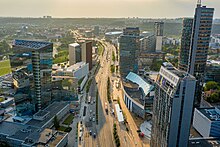立陶宛经济
来自维基百科,自由的百科全书
立陶宛是欧盟成员国,也是波罗的海三国中规模最大的经济体。2008年,立陶宛的人均GDP达17,800美元,是波罗的海三国的第二名,仅次于爱沙尼亚[26]。立陶宛是极高人类发展指数国家,也是世界贸易组织和经济合作与发展组织(OECD)成员国。立陶宛是前苏联的加盟共和国中,在1990年第一个宣布独立的国家,迅速由中央计划经济转变为市场经济,进行了许多的改革。立陶宛和其他波罗的海国家一起加入欧盟,之后成长速率很快,被称为波罗的之虎。自从1990年宣布独立时,立陶宛的GDP已成长超过五倍。波罗的海三国的劳动人口共有330万人,其中140万人住在立陶宛。
 维尔纽斯CBD | |
| 货币 | 欧元(EUR,€) |
|---|---|
| 财政年度 | 日历年 |
贸易组织 | 欧洲联盟、世界贸易组织、经济合作与发展组织 |
国家分组 | |
| 统计数据 | |
| 人口 | ▼ 2,794,090人(2020年1月1日)[3] |
| GDP | |
GDP增长率 |
|
人均GDP | |
人均GDP排名 | |
各产业GDP | |
| ▼ 35.4 中等(2019年,欧洲统计局资料)[8] | |
劳动力 | |
各产业劳动力 | |
| 失业率 | |
平均工资毛额 | 1,524欧元 / 1,852美元(每月,2020年第四季资料) |
| 968欧元 / 1,176美元(每月,2020年第四季资料) | |
主要产业 | 石油产业、食品加工业、能源产业、化学工业、家具、木制品、纺织和成衣[16] |
| ▲ 各国经商容易度列表[17] | |
| 对外贸易 | |
| 出口 | ▲ 291.2亿美元(2017年估计)[13] |
出口商品 | 精制燃料、机械和设备、化学品、纺织、食品、塑胶[13] |
主要出口伙伴 | |
| 进口 | ▲ 315亿美元(2017年估计)[13] |
进口商品 | 石油、天然气、机械和设备、运输设备、化学品、纺织品和服装、金属[13] |
主要进口伙伴 | |
外商直接投资存量 | |
| ▲ 3.64亿美元(2017年估计)[13] | |
外债总额 | ▲ 344.8亿美元(2016年3月3日估计)[13] |
| 公共财政 | |
| 收入 | GDP的35.2%(2019年)[18] |
| 支出 | GDP的34.9%(2019年)[18] |
| 经济援助 | EU结构协助:84亿欧元(约100亿美元),2014年至2020年[19] |
| ▼ 39亿欧元(2018年10月)[24] | |
除非另有说明,所有数据单位均为美元。 | |

立陶宛的GDP成长率在2008年时是最高的,在2018年时也有相近的成长率[27]。立陶宛和其他波罗的海国家一样,在2009年出现严重的衰退,GDP下降了大约15%。之后在2009年的第三季开始有恢复的迹象,在2010年时GDP上升了1.3%,在2011年的上半年成长了6.6%,是欧盟成长最快的国家之一[28]。2010年时GDP成长已以恢复,不过成长要比2008年之前缓和[29][30]。 克服金融危机的关键是立陶宛政府的紧缩政策[31]。
立陶宛的财政条件良好,2017年的预算盈余 0.5%,债务约占GDP的40%。2017年的预算没有赤字,预计2018年也是如此[32]。
在世界银行集团的各国经商容易度列表中,立陶宛排名第11名[33],在美国传统基金会针对178个国家的经济自由度指数中,立陶宛排名第16名[34]。平均来说,立陶宛的外商直接投资有95%是来自欧盟。历来瑞典就是立陶宛最大的投资者,约占FDI的20%至30%[35]。进入立陶宛的外商直接投资在2017年快速上升,是史上绿地投资数量最多的。2017年时,若考虑投资计划的平均就业价值,立陶宛是全球排名第三名,次于爱尔兰岛和新加坡[36]。若依经济合作与发展组织(OECD)的资料来看,立陶宛是OECD国家中,高等教育程度前五名的国家[37]。近年来,受高等教育的劳动力吸引了信息及通信技术的投资。立陶宛政府和立陶宛银行简化了电子货币和支付机构活动许可证的申请程序[38],因此在欧盟金融科技计划中,是相关具吸引力的国家。
参考资料
外部链接
Wikiwand - on
Seamless Wikipedia browsing. On steroids.
